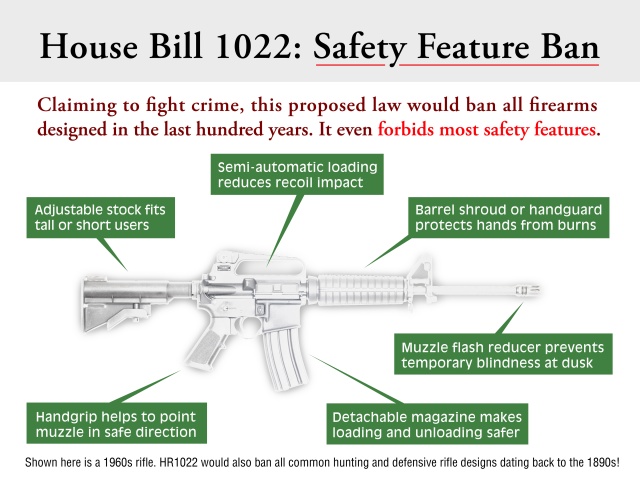|
|
|
Copyright
© A.D. 2007
by M.
D. Van
Norman.
|
|
Ironically, these
so-called assault weapons had continued to be manufactured and sold
throughout the life of the ban. The reason for this was as remarkably
simple as it was obvious. “Assault weapons” do not actually exist. They
are a fictional creation of clever propagandists.
The military defines an assault rifle as a select-fire weapon (capable
of a single shot, a burst of several shots, or continuous automatic
fire) chambered for an intermediate cartridge (one more powerful than a
handgun cartridge but less so than a full-sized rifle cartridge). In
other words, an assault rifle is a type of machine gun. Though certain
semi-automatic firearms (capable of only one shot per trigger pull) may
resemble military assault rifles in appearance, they do not meet this
definition.2 In
fact, machine guns and other automatic weapons have been tightly
controlled since the National Firearms Act of A.D.
1934.
Firearms prohibitionists have long known that they cannot successfully
outlaw all guns in one sweeping stroke. Therefore, they have adopted an
incremental strategy, focusing on one small aspect of firearms at a
time while attempting to divide gun owners in the process. The federal
ban on “assault weapons” was a perfect example of this.
The prohibitionists took advantage of the similar appearances between
civilian semi-automatic rifles and military assault rifles to confuse
the ignorant public during the campaign that led to the ban. The
mainstream news media supported this tactic both by implying that the
targeted firearms were machine guns and by overstating their
effectiveness as weapons. Politically, they successfully attempted to
divide hunters and casual gun owners from competitive and defensive
shooters.
|

This traditional Browning semi-automatic
rifle chambered for the powerful 7.62×63mm cartridge was not
prohibited.
|
Though
misinformation and propaganda won the day, the ban itself was largely
meaningless. Since assault rifles were already effectively illegal, the
authors of the legislation had to focus on the appearance of certain
largely ergonomic features, such as protruding pistol grips, adjustable
stocks, and flash
suppressors. Various combinations of these features were selected to
identify “assault weapons.” Additionally, certain firearms were
identified by their specific model names. To actually attack the
semi-automatic action of these firearms would have destroyed the
subterfuge of the legislation and would have united the gun-owning
community in opposition.
|

The configuration of features on this Stag
Arms 5.56×45mm carbine was banned, not
its semi-automatic action.
|
| Firearms
manufacturers responded by following
the law. They removed the prohibited features, renamed their models
when
necessary, and continued to sell their products. Therefore, during the
ban, it
was still possible for civilians to buy semi-automatic firearms that
superficially resembled military assault rifles. After 10 years, the
ban
expired uneventfully, save for a few hysterical news stories and some
disingenuous posturing by politicians.3 |

The ergonomic features that defined
“assault weapons” did not make them any more dangerous than other
firearms.
|
In
conclusion, there is no such thing as
“assault weapons.” They are a myth. Even in California, where a more
stringent
ban on “assault
weapons”
remains in effect, semi-automatic rifles that merely differ in
appearance from
the banned weapons are still perfectly legal.
|
1
|
Violent
Crime Control and Law Enforcement Act of 1994.
|
2
|
Comparing
rates of fire, a modern semi-automatic pistol is not appreciably faster
than a double-action revolver from the 19th-century A.D.
|
3
|
Even
if the ban had been effective, criminal misuse of semi-automatic rifles
was already
rare. Criminals prefer the convenience and
concealability of handguns.
|
|
|





